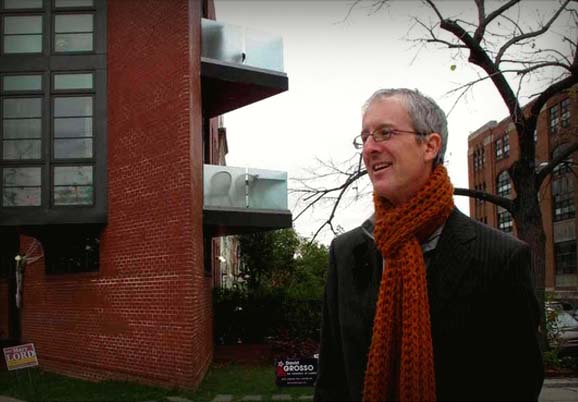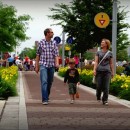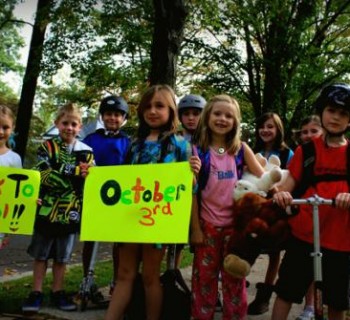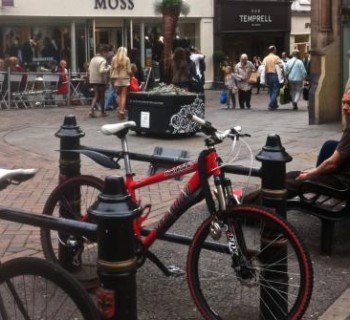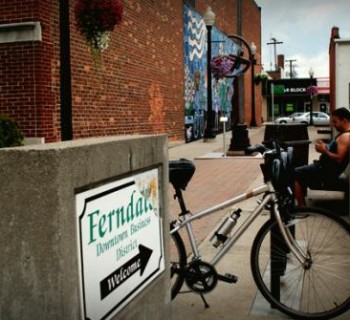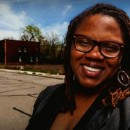Written by Ash Blankenship on Parksify. Reposted with permission.
For many cities, the concept of walkability is limited. Planners and engineers often fail to understand how walkable cities influence the daily lives of residents.
Jeff Speck, an AICP-certified city planner and architectural designer explained the importance of walkability in his book, Walkable City: How Downtown Can Save the City One Step at a Time.
Speck has advocated for improved walkability in cities and has spoken about the issue with NPR and Metropolis Magazine, and has been featured in the Washington Post, Architect Magazine and Planetizen. I had the opportunity to discuss walkability with Speck via email.
Ash Blankenship: Can you describe exactly what “walkability" is? What is your one-minute pitch to explain the subject?
Jeff Speck: Walkability is the degree to which an environment welcomes and indeed entices pedestrian activity and, by extension, cycling. I was just working on a walkability study for downtown Boise, and I described my scope of work as this: “I am doing my best to figure out how you can, in the shortest amount of time and for the least amount of money, most dramatically increase the number of pedestrians and cyclists downtown."
Ash: Since walkability is more involved than simply developing sidewalks, what factors must be considered to create a truly walkable city?
Jeff: Most professionals who focus on walkability look almost exclusively at how safe the walk is. Walk Score, the web tool, focuses just on how useful the walk can be… what activities are located close at hand? These are two necessary prerequisites to creating pedestrian culture, two out of at least four. I like to say that people with cars (most Americans) will only make the choice to walk if the walk is simultaneously useful, safe, comfortable, and interesting. Comfort refers to well-shaped street spaces (with good vertical edges) while interest refers to the need for signs of human habitation. Blank walls and bushes don’t cut it, no matter how safe and useful a walk may be.
"Blank walls and bushes don’t cut it, no matter how safe and useful a walk may be"
Ash: You wrote in Walkable City that “[s]ixty-four percent of college-educated millennials choose first where they want to live, and only then do they look for a job. Fully 77 percent of them plan to live in America’s urban cores.” This is a vast amount of young people who are moving to America’s cities. Can the concept and planning of walkability keep up with the growing demand?
Jeff: The downtowns that invested in walkability a decade ago are quickly becoming unaffordable to millennials. But the typical American downtown, like an Oklahoma City or a Davenport, Iowa, is only beginning to provide the walkability that will keep nearby millennials from trying to live in Austin or in Chicago instead. These second-tier cities, where downtown housing is more rare than expensive, have a tremendous capacity to revitalize themselves around a millennial influx, but only those that invest now in walkability will do so.
Ash: There is an added expense with living in a walkable neighborhood. You mentioned in Walkable City that people are paying three times as much per square feet as they would a suburban home. Does this limit walkable neighborhoods only to those who can afford them? If so, do you think the costs associated with living in walkable areas will result in displacement of low-income residents?
Jeff: I am amazed at the degree to which people don’t do the math. The typical American “working" family works January through April just to pay for its cars. Get rid of one of those cars — or both — and you can pay a heck of a lot more for housing. That is not to say that cities don’t have to take pains to ensure availability of attainable housing downtown, particularly for existing renters who are likely to be priced out by gentrification. I am working in Babylon, NY, where a great new TOD [Transit Oriented Development] is about to bump the value of real estate around a currently downtrodden Long Island Rail Road station. The Town had the foresight to establish a home ownership program that is actively calling renters and turning them into owners. It is our obligation to make such efforts when we aim to improve places.
Much of NYC has a high walk score, but there’s more to walkability.
Ash: “While most American cities were building more highways, Portland [Oregon] invested in transit and biking,” you wrote in Walkable City. How has this investment resulted in improved walkability and public spaces? What can other cities learn from Portland’s efforts?
Jeff: Portland spent $60 million on biking over a couple dozen years. It seems like a lot of money, but it was less than half the cost of rebuilding just one of their highway cloverleafs. That investment caused Portlanders to bike at a rate 15 times the national average, despite the hills and the rain. Similar investments in transit, coupled with an urban growth boundary, caused Portland’s Vehicle Miles Travelled per capita to peak in 1996 and decline steadily since. Portlanders now drive 4 miles less per day than they did back then. Investments in biking and transit allow more citizens to get around without cars, which allows the whole urban landscape to take shape once again around the scale of the pedestrian. Other cities can compare these outcomes to their own experience, which almost always shows one thing: the more space and time you give the car, the more it takes.
“the more space and time you give the car, the more it takes.”
Ash: In your book, you said that “street trees are key to pedestrian comfort and urban livability in so many ways.” Statistics have shown that higher crime prevails in areas with fewer trees. In addition to creating more walkable comforts for pedestrians, is it possible for cities to lower crime rates by simply planting more trees?
Jeff: Let’s not confuse correlation with causality. Lower crime also tends to happen in richer places, places [which] tend to have more trees. But trees are an important component in creating the sort of comfortable, inviting environment that is likely to attract the street life that makes crime less likely. Planting trees is one great way to care about a place in the manner that deters crime. Nothing is better for public safety than for a place to be loved.
Ash: How do public spaces, such as squares and parks affect walkability in cities? Do they offer a respite from the rush of typical city living?
Jeff: Yes, they do, but they are less important to walkability than they are to people’s happiness living in a place, and certainly to their willingness to stay in a neighborhood after having children. The simplest answer is that we city builders owe the public these places. Mayor Joe Riley of Charleston reminds us that, for many citizens, the city is all they have. We can’t all get on an airplane when we need a fix of top quality landscape — or urbanism. If it is to allow us to be our best selves, the city must offer places that make the heart sing.
You can learn more about Jeff Speck by visiting his website or by following him on Twitter. For anyone interested in learning more about walkability, I highly recommend Jeff’s book, Walkable City.
ABOUT THE AUTHOR
Ash is the founder and Editor-in-Chief of Parksify and also writes about urban policies, technology, sociology and other topics for a range of publications, including Urban Times, Medium, Tiny Buddha and others.
Prior to founding Parksify, Ash worked at the Center for Public Integrity, a Washington-based nonprofit journalism organization.


